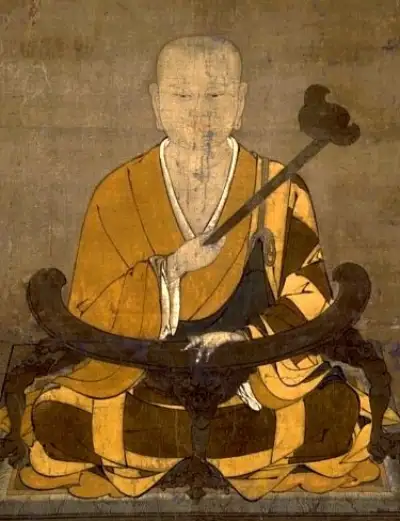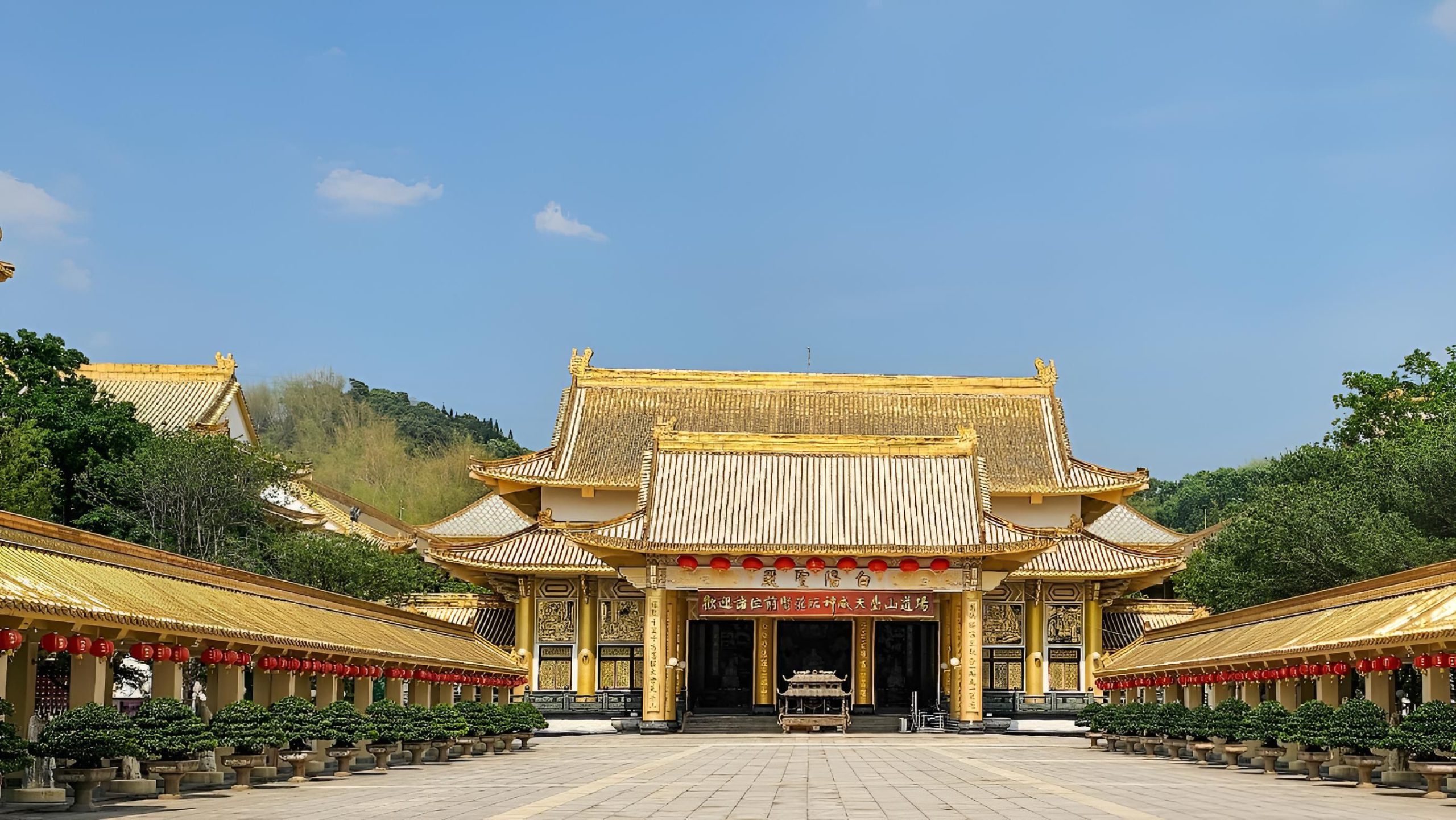Zhiyi (智顗, 538–597) Founder of the Tiantai School of Chinese Buddhism

Overview
Zhiyi (智顗, pronounced Jì-yǐ) was the founder of the Tiantai School of Chinese Buddhism and one of the most influential Buddhist monks in East Asian history. Living during the turbulent Northern and Southern Dynasties and the rise of the Sui dynasty, Zhiyi established a complete system of doctrine and meditation rooted in the Lotus Sutra (法華經), uniting philosophy, ethics, and contemplation into a single path toward awakening.
At his home on Mount Tiantai (天台山) in Zhejiang, China (Guoqing Temple became the ancestral seat), Zhiyi created a spiritual synthesis that became the foundation for both Chinese Tiantai and Japanese Tendai Buddhism. His writings, particularly the Mohe Zhiguan (Great Calming and Contemplation), remain among the most detailed manuals on Buddhist meditation ever produced.
Core sutra: Lotus Sutra (法華經)
Core Concepts
- Threefold Truth (空假中): Emptiness, provisional existence, and the Middle Way
- Ten Realms and Mutual Possession (十界互具): All states of being contain one another
- Zhǐ-guān (止觀): The integrated practice of calming and insight meditation
- Contemplation in a Single Thought (一念三千): Each moment contains all causes, conditions, and results
Early Life and Background
Zhiyi was born in 538 CE in Huayang (present-day Hubei Province), during an era of division and civil unrest. Buddhism had already flourished in China for several centuries, with diverse schools interpreting the teachings of India through the lens of Chinese culture and philosophy, but as yet these schools were not united.
From an early age, Zhiyi showed deep spiritual sensitivity. After entering monastic life, he was drawn to meditation and scripture study. The chaotic political landscape of his time, the collapse of dynasties and the search for moral order, fostered a climate ripe for a new Buddhist synthesis, one that Zhiyi would soon create.
Training Under Huisi and the Roots of Tiantai Meditation
Zhiyi’s most formative influence was Huisi (慧思, 515–577), an eminent meditation master on Mount Dasu. Under Huisi’s guidance, Zhiyi trained in the zhǐ-guān method, a balanced cultivation of calm (śamatha) and insight (vipaśyanā).
Huisi is said to have predicted Zhiyi’s future as the true heir of the Lotus Sutra lineage, entrusting him with the transmission of deep meditative wisdom. Zhiyi’s early years of practice included long solitary retreats in mountains and temples across southern China, laying the groundwork for his later doctrinal system.
Who was Zhiyi?
Zhiyi (智顗, 538–597 CE) was a Chinese Buddhist monk and the founder of the Tiantai School (天台宗), the first fully integrated system of Buddhist philosophy and meditation in China. Building on the Lotus Sutra and the teachings of his master Huisi, Zhiyi developed the zhǐ-guān (止觀, calming and insight) practice and philosophical frameworks such as the Threefold Truth and the Ten Realms.
Teaching from Mount Tiantai in Zhejiang, he united scripture, reasoning, and contemplation into a single path of awakening accessible to all beings. His seminal works, Mohe Zhiguan (Great Calming and Contemplation), Fahua Xuanyi (Profound Meaning of the Lotus Sutra), and Fahua Wenju (Words and Phrases of the Lotus Sutra), became classics of East Asian Buddhist thought.
Zhiyi’s synthesis later spread to Japan as Tendai Buddhism and continues to influence Zen, Nichiren, and Pure Land traditions. His legacy endures as a visionary who revealed enlightenment within every moment of ordinary life.
Formation of the Tiantai School on Mount Tiantai
In the late 560s, Zhiyi settled on Mount Tiantai, where his teaching matured into a cohesive vision of Buddhism. From here he taught disciples, composed his major works, and built over thirty temples.
Guoqing Temple (國清寺) on Mount Tiantai became the ancestral seat of the Tiantai tradition, a centre of meditation, scholarship, and ethical discipline.
Zhiyi’s synthesis drew together diverse Buddhist philosophies:
- The Mādhyamika insight into emptiness
- The Yogācāra understanding of consciousness
- The Lotus Sutra’s vision of universal enlightenment
His genius was to present these not as conflicting doctrines but as mutually inclusive expressions of the same truth.

Zhiyi’s Major Works
Mohe Zhiguan (摩訶止觀, Great Calming and Contemplation)
Zhiyi’s magnum opus and a cornerstone of Chinese Buddhist meditation. It offers precise guidance on posture, breath, and concentration; explains psychological obstacles and their remedies; and elaborates on the Four Samādhis:
- Constant sitting
- Constant walking
- Half-walking, half-sitting
- Neither walking nor sitting
Each Samādhi is a structured retreat format integrating stillness and movement, designed to reveal the unity of mind and world.
Fahua Xuanyi (法華玄義, Profound Meaning of the Lotus Sutra)
This text presents Zhiyi’s hermeneutical framework for understanding the Lotus Sutra through the “Five Profound Meanings”:
- The title (name)
- The substance (essence)
- The principle (truth)
- The function (application)
- The teachings (methods)
It serves as a gateway into Tiantai thought, showing how a single sutra embodies the totality of the Buddha’s wisdom.
Fahua Wenju (法華文句, Words and Phrases of the Lotus Sutra)
A detailed, line-by-line commentary on the Lotus Sutra, compiled with the help of Zhiyi’s disciple Guanding (灌頂). It became the standard reference for monastic study and public preaching throughout East Asia.
Key Doctrines of Tiantai Philosophy
The Threefold Truth (空假中)
Zhiyi’s philosophical centrepiece is the Threefold Truth:
- Emptiness (空): All phenomena lack inherent existence.
- Provisional Existence (假): Yet they appear and function within worldly causality.
- The Middle (中): Reality is simultaneously empty and provisionally existent, without contradiction.
This triadic view reconciles all dualities: nirvāṇa and saṃsāra, wisdom and compassion, form and emptiness.
The Ten Realms and Their Mutual Possession (十界互具)
From the lowest hell realm to the highest Buddhahood, every realm contains all others. Thus, even a single thought of an ordinary person contains the potential of enlightenment, and a Buddha encompasses all living beings.
This dynamic interpenetration of worlds led Zhiyi to describe existence as “three thousand realms in a single thought-moment” (一念三千).
The Four Samādhis and the Path of Practice
Zhiyi’s Four Samādhis outline a complete cycle of meditative discipline adaptable to monks and lay practitioners alike.
They harmonize stillness and movement, ritual and daily life, encouraging meditation not as escape but as active participation in reality itself.
(See also: The Four Samādhis Explained →)
Contemplation in a Single Thought
Perhaps Zhiyi’s most profound insight: “In one instant of mind, all causes, conditions, and effects throughout the cosmos interpenetrate.”
This means that enlightenment is not distant, it is accessible in every moment of awareness, every ordinary act, when viewed through the lens of wisdom and compassion.
Influence on East Asian Buddhism
Zhiyi’s teaching spread rapidly after his death in 597 CE. His disciple Guanding preserved and systematised his works, ensuring their transmission throughout China.
In the early 9th century, the Japanese monk Saichō (最澄) brought Tiantai teachings to Japan, founding the Tendai School (天台宗) on Mount Hiei. Through Tendai, Zhiyi’s influence reached the founders of later traditions such as Nichiren Buddhism, Zen, and Pure Land.
His methods also shaped Chinese Chan meditation, Korean Cheontae, and Vietnamese Thiên Thai traditions.
Practice in Daily Life: Applying Zhiyi’s Teachings
Tiantai practice emphasizes balance: study, meditation, and ethical living.
- Read and contemplate a chapter of the Lotus Sutra daily.
- Pair sutra reading with a brief Four Samādhis session, alternating quiet sitting and walking meditation.
- On lunar observance days, dedicate recitation to “opening the Buddha-wisdom” for self and others.
These simple forms allow modern practitioners to participate in Zhiyi’s vision of awakening “within the ordinary mind.”
(See also: The Tiantai Calendar of Observances →)
Legacy and Reverence
Zhiyi’s passing in 597 CE marked the crystallisation of Tiantai as one of the great schools of Chinese Mahāyāna Buddhism. He was posthumously honored as Great Master Zhizhe (智者大師), “the Wise and Enlightened Teacher.”
The Tiantai tradition continues to thrive in mainland China, Taiwan, and Japan. Guoqing Temple remains a pilgrimage site, with statues and relics commemorating Zhiyi’s life and teachings.
Zhiyi in Modern Scholarship
In modern academia, Zhiyi is recognised as one of the most systematic thinkers in Buddhist history. His writings prefigure both phenomenology and systems theory, treating consciousness and cosmos as mutually reflecting structures.
Important studies include:
- Brook A. Ziporyn, Emptiness and Omnipresence: An Essential Introduction to Tiantai Buddhism
- Paul L. Swanson, Foundations of T’ien-t’ai Philosophy
- Donner & Stevenson, The Great Calming and Contemplation: A Study and Annotated Translation
Digital resources:
- CBETA (Chinese Buddhist Electronic Text Association)
- BDK English Tripiṭaka Project
Recommended Reading
- Mohe Zhiguan (Great Calming and Contemplation) – Translated by Donner & Stevenson
- The Lotus Sutra – Translated by Burton Watson (Columbia University Press)
- Emptiness and Omnipresence – Brook A. Ziporyn
- Foundations of T’ien-t’ai Philosophy – Paul L. Swanson
📚 Further resources:
What Is Tiantai Buddhism? →
The Four Samādhis Explained →
Tiantai Buddhist Calendar (ICS) →
Zhiyi FAQ
Who was Zhiyi?
Zhiyi (538–597 CE) was a Chinese Buddhist monk and founder of the Tiantai School. Building on the Lotus Sutra, he created a system uniting philosophy, meditation, and ethics that shaped East Asian Buddhism.
What is Tiantai Buddhism?
Tiantai Buddhism is a Chinese Mahayana school founded by Zhiyi that emphasizes the Lotus Sutra, the Threefold Truth (emptiness, provisional existence, and the middle), and the integrated meditation of calming and insight (zhiguan).
What are Zhiyi’s main works?
Zhiyi’s major writings include the Mohe Zhiguan (Great Calming and Contemplation), the Fahua Xuanyi (Profound Meaning of the Lotus Sutra), and the Fahua Wenju (Words and Phrases of the Lotus Sutra).
What did Zhiyi teach about meditation?
Zhiyi taught zhiguan—calming and insight—as a balanced path of meditation combining stillness, mindfulness, and insight into the interdependence of all things. His Four Samādhis provided structured methods for monks and lay practitioners alike.
How did Zhiyi influence later Buddhism?
Zhiyi’s Tiantai system was transmitted to Japan as Tendai Buddhism and influenced Zen, Nichiren, and Pure Land traditions. His synthesis of theory and practice remains a cornerstone of East Asian Buddhist thought.

